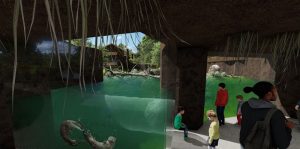$18M habitat planned for Iowa otters, eagles, bobcats, turtles and more
November 6th, 2025 by Ric Hanson
(Radio Iowa) – Ground is being broken today (Thursday) at the state’s largest zoo on an 18-million dollar expansion called Wild Iowa, which will showcase various species that are all native to Iowa. Alex Payne, spokesman for Blank Park Zoo in Des Moines, says it’ll be their first installation for bobcats, and nearby they’ll build a new habitat for American bald eagles, which will include a place where the big birds can perch above visitors.
“There will be some enclosure there for them, but it will be a brighter area so they’ll be able to receive more sunlight than they have in their current habitat, and more room for them to be able to go out and explore around the area,” Payne says. Another section of the new exhibition will be dedicated to river otters, and it will offer visitors an up-close underwater view of the playful creatures. Payne says it’ll be a big improvement over the current otter habitat.

Otter Habitat (Blank Park Zoo image)
“We will move our otters over to the new Wild Iowa section, so the bald eagles and otters will be moving over there, and then next to that, we’ll also have our bobcat area that we’ll be adding, and then we’ll also have our Discovery Cabin and we’ll include some Blanding’s turtles, which are native to Iowa, and some other animals that are native to the Iowa area.” Today’s groundbreaking event also marks the launch of the zoo’s 60th anniversary, what Payne says will be a year-and-a-half-long celebration of the zoo’s past, and the exciting things that are still to come.
“We broke ground in May on our new lion habitat, so that will open next summer, and that’s part of our overall Expand the Impact campaign,” Payne says. “Then Wild Iowa, we’ll be breaking ground now and then that will probably be about a year, so we’re looking into probably spring of 2027 for Wild Iowa.” What was originally called the Des Moines Children’s Zoo opened in May of 1966. It now draws about a half-million visitors every year.


